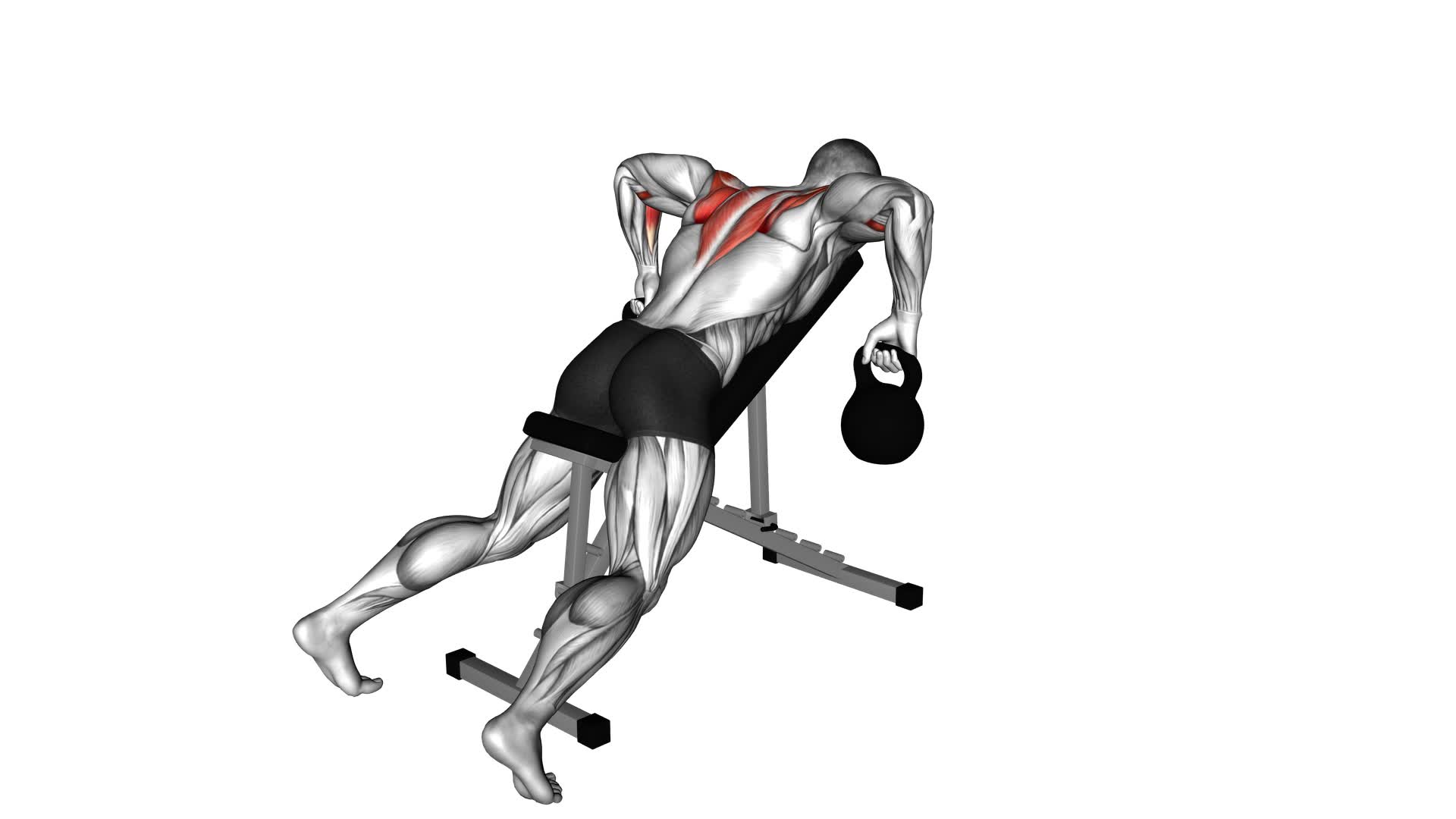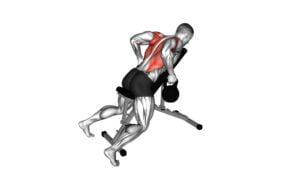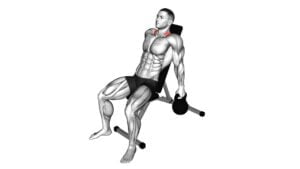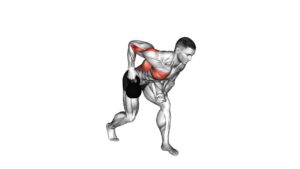Kettlebell Incline Row – Video Exercise Guide & Tips

Are you looking to strengthen your back muscles and improve your posture? Look no further than the kettlebell incline row.
Watch This Exercise Video
This video exercise guide will show you the proper form and technique, along with variations to increase the difficulty. Avoid common mistakes and stay safe with our expert tips.
Get ready to challenge yourself and achieve a stronger, more toned back with the kettlebell incline row. Let's get started!
Key Takeaways
- Kettlebell Incline Row is an effective exercise for increasing strength and muscle growth in the upper back and arms.
- Proper form and technique are important to maximize the benefits of the exercise and prevent injuries.
- There are various variations to increase the difficulty of the exercise and continue challenging the muscles.
- It is crucial to avoid common mistakes such as using too much weight, rounding the back, and not engaging the core to ensure safety and effectiveness.
Benefits of Kettlebell Incline Row
You will experience increased strength and muscle growth in your upper back and arms when you perform the Kettlebell Incline Row. This exercise targets several key muscles, including the latissimus dorsi, rhomboids, trapezius, biceps, and forearms. By incorporating the Kettlebell Incline Row into your workout routine, you can effectively develop and strengthen these muscle groups.
To perform the Kettlebell Incline Row, start by setting an incline bench at a slight angle. Place a kettlebell on the floor next to the bench. Position yourself facing the bench, with one hand resting on the bench for support. With the other hand, pick up the kettlebell and let it hang down towards the floor. Pull the kettlebell up towards your chest, keeping your elbow close to your body. Squeeze your shoulder blades together at the top of the movement, then slowly lower the kettlebell back down to the starting position. Repeat for the desired number of repetitions.
Incorporating the Kettlebell Incline Row into your workout routine can help improve your overall upper body strength and increase muscle definition in your back and arms. This exercise can be performed as part of a circuit training routine or as a standalone exercise.
Now, let's move on to the next section, where we'll discuss the proper form and technique for the Kettlebell Incline Row.
Proper Form and Technique
To ensure proper execution of the Kettlebell Incline Row, focus on maintaining a stable position and engaging the targeted muscles throughout the exercise. Proper form and technique are essential to maximize the effectiveness of this exercise and prevent injury.
One common error to avoid is using too much momentum. It's important to control the movement and avoid swinging the kettlebell. Instead, focus on pulling the weight up using your back muscles and maintaining a slow and controlled pace. This will ensure that the targeted muscles are properly engaged and activated.
Another common mistake is rounding the shoulders and hunching the back. To maintain proper form, keep your shoulders pulled back and down, and your chest lifted. This will help to engage the upper back muscles and prevent strain on the neck and shoulders.
In terms of muscle activation, the Kettlebell Incline Row primarily targets the muscles of the upper back, including the latissimus dorsi, rhomboids, and rear deltoids. It also engages the biceps and core muscles as stabilizers. By focusing on proper form and technique, you can ensure that these muscles are effectively activated during the exercise.
Variations to Increase Difficulty
To increase the difficulty of the Kettlebell Incline Row, incorporate variations that challenge your muscles in new ways. There are several progression options and advanced modifications that can make this exercise more challenging and effective.
One option is to increase the weight of the kettlebell. Start with a lighter weight and gradually work your way up as your muscles become stronger. This will increase the resistance and intensity of the exercise.
Another option is to perform the exercise on a higher incline. By raising the bench or platform, you'll be working against gravity at a steeper angle, which will engage your muscles even more.
You can also try performing the exercise with one arm at a time. This will require more stability and core strength, making the exercise more challenging overall.
Finally, you can add a pause at the top of the movement. This will increase the time under tension and further engage your muscles.
Incorporating these variations will help you continue to progress and challenge your muscles as you become stronger. Remember to always maintain proper form and technique to avoid injury and get the most out of your workout.
Common Mistakes to Avoid
When performing the Kettlebell Incline Row, it's important to be aware of common mistakes to avoid. By avoiding these mistakes, you can minimize the risk of injuries and maximize your results.
Here are the common mistakes to watch out for:
- Using too much weight: It's crucial to start with a weight that you can handle comfortably. Using too heavy of a kettlebell can lead to improper form and increase the risk of straining your muscles.
- Rounding your back: Keeping a straight back is essential during the exercise. Avoid rounding your back, as it can put unnecessary stress on your spine and lead to back injuries.
- Pulling with your arms: The primary focus of the Kettlebell Incline Row should be on your back muscles. Avoid relying solely on your arms to perform the movement, as it can reduce the effectiveness of the exercise.
- Not engaging your core: Engaging your core muscles throughout the exercise helps maintain stability and proper form. Neglecting your core can lead to compromised technique and potential injuries.
- Lifting your hips: Keep your hips in a stable position throughout the exercise. Lifting your hips can shift the emphasis away from your back muscles and decrease the effectiveness of the workout.
Safety Tips for Kettlebell Incline Row
To ensure a safe and effective Kettlebell Incline Row workout, it's important to follow these safety tips. By taking precautions, you can prevent injuries and maximize your results.
Firstly, it's crucial to maintain proper form throughout the exercise. Keep your back straight and engage your core muscles to protect your spine. Avoid rounding your shoulders or arching your lower back, as this can lead to strain or injury.
Secondly, start with a weight that's appropriate for your fitness level. Gradually increase the weight as you become stronger and more comfortable with the exercise. Using too heavy of a weight can put unnecessary stress on your muscles and joints.
Next, always warm up before starting your Kettlebell Incline Row workout. This can include dynamic stretches and light cardio exercises to increase blood flow and prepare your body for the workout ahead.
Additionally, listen to your body and don't push yourself beyond your limits. If you experience pain or discomfort during the exercise, stop immediately and seek guidance from a fitness professional.
Lastly, remember to breathe properly throughout the exercise. Exhale as you pull the kettlebell towards your chest and inhale as you lower it back down. This will help you maintain control and stability.
Frequently Asked Questions
How Many Sets and Reps Should I Do for the Kettlebell Incline Row?
For the kettlebell incline row, you may wonder how many sets and reps to do.
To determine the right approach, consider whether you should do higher reps or heavier weight.
Additionally, think about how you can properly progress and challenge yourself with this exercise.
Can I Use Dumbbells Instead of Kettlebells for the Incline Row Exercise?
Yes, you can definitely use dumbbells instead of kettlebells for the incline row exercise. Dumbbells are a great alternative that can provide similar benefits to the exercise.
The incline row targets your upper back, shoulders, and biceps, helping to improve your posture and strengthen your upper body.
By using dumbbells, you can still perform the exercise effectively and achieve the desired results.
Is the Kettlebell Incline Row Suitable for Beginners?
Yes, the kettlebell incline row is suitable for beginners.
It's a great exercise for building upper body strength and targeting your back muscles.
To progress, you can increase the weight of the kettlebell or adjust the angle of the incline bench.
When performing the exercise, be sure to maintain a neutral spine and avoid pulling with your arms.
Instead, focus on engaging your back muscles to initiate the movement.
Can I Perform the Incline Row Exercise Without an Incline Bench?
Yes, you can perform the incline row exercise without an incline bench. There are alternative exercise variations you can try to target the same muscle groups.
By using a stability ball or a low bar, you can simulate the incline position and still engage your upper back and arms effectively.
The benefits of performing incline rows without a bench include improved posture, increased upper body strength, and enhanced shoulder stability.
What Muscles Does the Kettlebell Incline Row Primarily Target?
The kettlebell incline row primarily targets your back muscles, specifically the rhomboids, lats, and traps. This exercise is great for building upper body strength and improving posture.
You can perform variations of the kettlebell incline row to target different muscle groups and add variety to your workout routine. It's important to maintain proper form and technique by keeping your back straight, retracting your shoulder blades, and pulling the kettlebell towards your body with controlled movements.
Conclusion
In conclusion, the kettlebell incline row is a highly effective exercise for targeting the muscles of the upper back and arms. By maintaining proper form and technique, you can maximize the benefits of this exercise and avoid common mistakes.
Additionally, incorporating variations to increase difficulty will challenge your muscles even more. Remember to prioritize safety by starting with a manageable weight and gradually increasing as you build strength and confidence.

Author
Years ago, the spark of my life’s passion ignited in my mind the moment I stepped into the local gym for the first time. The inaugural bead of perspiration, the initial endeavor, the very first surge of endorphins, and a sense of pride that washed over me post-workout marked the beginning of my deep-seated interest in strength sports, fitness, and sports nutrition. This very curiosity blossomed rapidly into a profound fascination, propelling me to earn a Master’s degree in Physical Education from the Academy of Physical Education in Krakow, followed by a Sports Manager diploma from the Jagiellonian University. My journey of growth led me to gain more specialized qualifications, such as being a certified personal trainer with a focus on sports dietetics, a lifeguard, and an instructor for wellness and corrective gymnastics. Theoretical knowledge paired seamlessly with practical experience, reinforcing my belief that the transformation of individuals under my guidance was also a reflection of my personal growth. This belief holds true even today. Each day, I strive to push the boundaries and explore new realms. These realms gently elevate me to greater heights. The unique combination of passion for my field and the continuous quest for growth fuels my drive to break new ground.







